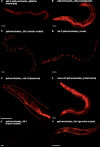Split-wrmScarlet and split-sfGFP: tools for faster, easier fluorescent labeling of endogenous proteins in Caenorhabditis elegans
- PMID: 33693628
- PMCID: PMC8049552
- DOI: 10.1093/genetics/iyab014
Split-wrmScarlet and split-sfGFP: tools for faster, easier fluorescent labeling of endogenous proteins in Caenorhabditis elegans
Abstract
We create and share a new red fluorophore, along with a set of strains, reagents and protocols, to make it faster and easier to label endogenous Caenorhabditis elegans proteins with fluorescent tags. CRISPR-mediated fluorescent labeling of C. elegans proteins is an invaluable tool, but it is much more difficult to insert fluorophore-size DNA segments than it is to make small gene edits. In principle, high-affinity asymmetrically split fluorescent proteins solve this problem in C. elegans: the small fragment can quickly and easily be fused to almost any protein of interest, and can be detected wherever the large fragment is expressed and complemented. However, there is currently only one available strain stably expressing the large fragment of a split fluorescent protein, restricting this solution to a single tissue (the germline) in the highly autofluorescent green channel. No available C. elegans lines express unbound large fragments of split red fluorescent proteins, and even state-of-the-art split red fluorescent proteins are dim compared to the canonical split-sfGFP protein. In this study, we engineer a bright, high-affinity new split red fluorophore, split-wrmScarlet. We generate transgenic C. elegans lines to allow easy single-color labeling in muscle or germline cells and dual-color labeling in somatic cells. We also describe a novel expression strategy for the germline, where traditional expression strategies struggle. We validate these strains by targeting split-wrmScarlet to several genes whose products label distinct organelles, and we provide a protocol for easy, cloning-free CRISPR/Cas9 editing. As the collection of split-FP strains for labeling in different tissues or organelles expands, we will post updates at doi.org/10.5281/zenodo.3993663.
Keywords: C. elegans; CRISPR; Cas9; GFP; genome engineering; germline; mScarlet; protein localization; wrmScarlet.
© The Author(s) 2021. Published by Oxford University Press on behalf of Genetics Society of America.
Figures





References
-
- Bindels DS, Haarbosch L, van Weeren L, Postma M, Wiese KE, et al.2017. mScarlet: a bright monomeric red fluorescent protein for cellular imaging. Nat Methods 14:53–56. - PubMed
-
- Cabantous S, Terwilliger TC, Waldo GS.. 2005. Protein tagging and detection with engineered self-assembling fragments of green fluorescent protein. Nat Biotechnol. 23:102–107. - PubMed
Publication types
MeSH terms
Substances
Grants and funding
LinkOut - more resources
Full Text Sources
Other Literature Sources
Research Materials

